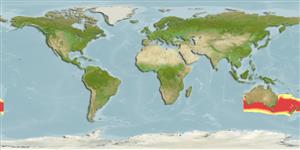Environment: milieu / climate zone / depth range / distribution range
Ecologie
marien; brak water; diepte 22 - 500 m (Ref. 58489), usually ? - 150 m (Ref. 9072). Subtropical; 23°S - 50°S, 112°E - 176°W
Southwest Pacific: Australia and New Zealand waters. Two subpopulations probably exist in the Great Australian Bight and southeastern Australia, respectively, and two species or subspecies in the southeastern group (Ref. 7456).
Lengte bij maturiteit / Grootte / Gewicht / Leeftijd
Maturity: Lm 20.0 range ? - ? cm
Max length : 50.0 cm SL mannelijk / geslacht onbekend; (Ref. 33839); common length : 35.0 cm TL mannelijk / geslacht onbekend; (Ref. 9258); max. gerapporteerde leeftijd: 25 Jaren (Ref. 9072)
Dorsale stekels (totaal) : 9; Dorsale zachte stralen (totaal) : 27 - 33; Anale stekels: 3; Anale zachte stralen: 22 - 29; Wervels: 24. Adults are elongate and compressed, and have a primary lateral line with 67-81 scutes, a secondary lateral line reaching to dorsal-fin ray 2, and a yellow caudal fin.
Adults occur in coastal waters, including estuaries (Ref. 9563), mostly in waters shallower than 150 m and warmer than 13°C (Ref. 9072). Commonly found on the bottom, in midwater and occasionally at the surface (Ref. 9258), in large schools (Ref. 33616). Adults are generally found over offshore rocky reefs, while juveniles are generally found in shallow, soft substrate areas (Ref. 6390). Utilized fresh, smoked, canned and frozen; can be fried, broiled and baked (Ref. 9988).
Paxton, J.R., D.F. Hoese, G.R. Allen and J.E. Hanley, 1989. Pisces. Petromyzontidae to Carangidae. Zoological Catalogue of Australia, Vol. 7. Australian Government Publishing Service, Canberra, 665 p. (Ref. 7300)
Status op de Rode Lijst van het IUCN (Ref. 130435: Version 2024-1)
Gevaar voor de mens
Harmless
Gebruik door de mens
Visserij: commercieel; sportvis: ja; aas: usually
Tools
Speciale rapporten
Download XML
Internetbronnen
Estimates based on models
Preferred temperature (Ref.
123201): 13.1 - 21.2, mean 15.3 °C (based on 70 cells).
Fylogenetische diversiteitsindex (Ref.
82804): PD
50 = 0.5001 [Uniqueness, from 0.5 = low to 2.0 = high].
Bayesian length-weight: a=0.01778 (0.01021 - 0.03098), b=2.99 (2.84 - 3.14), in cm total length, based on LWR estimates for this species & Genus-body shape (Ref.
93245).
Trofisch niveau (Ref.
69278): 3.2 ±0.40 se; based on food items.
Generation time: 3.7 ( na - na) years. Estimated as median ln(3)/K based on 2
growth studies.
Weerstandsvermogen (Ref.
120179): Gemiddeld, minimale populatieverdubbelingstijd 1,4-4,4 jaar (K=0.30; tm=3-4; tmax=25).
Fishing Vulnerability (Ref.
59153): Moderate vulnerability (37 of 100).
Nutrients (Ref.
124155): Calcium = 263 [161, 434] mg/100g; Iron = 3.76 [2.23, 6.42] mg/100g; Protein = 19.8 [19.0, 20.5] %; Omega3 = 0.383 [0.249, 0.578] g/100g; Selenium = 26.8 [14.7, 49.8] μg/100g; VitaminA = 8.05 [2.13, 29.13] μg/100g; Zinc = 2.37 [1.72, 3.33] mg/100g (wet weight);
